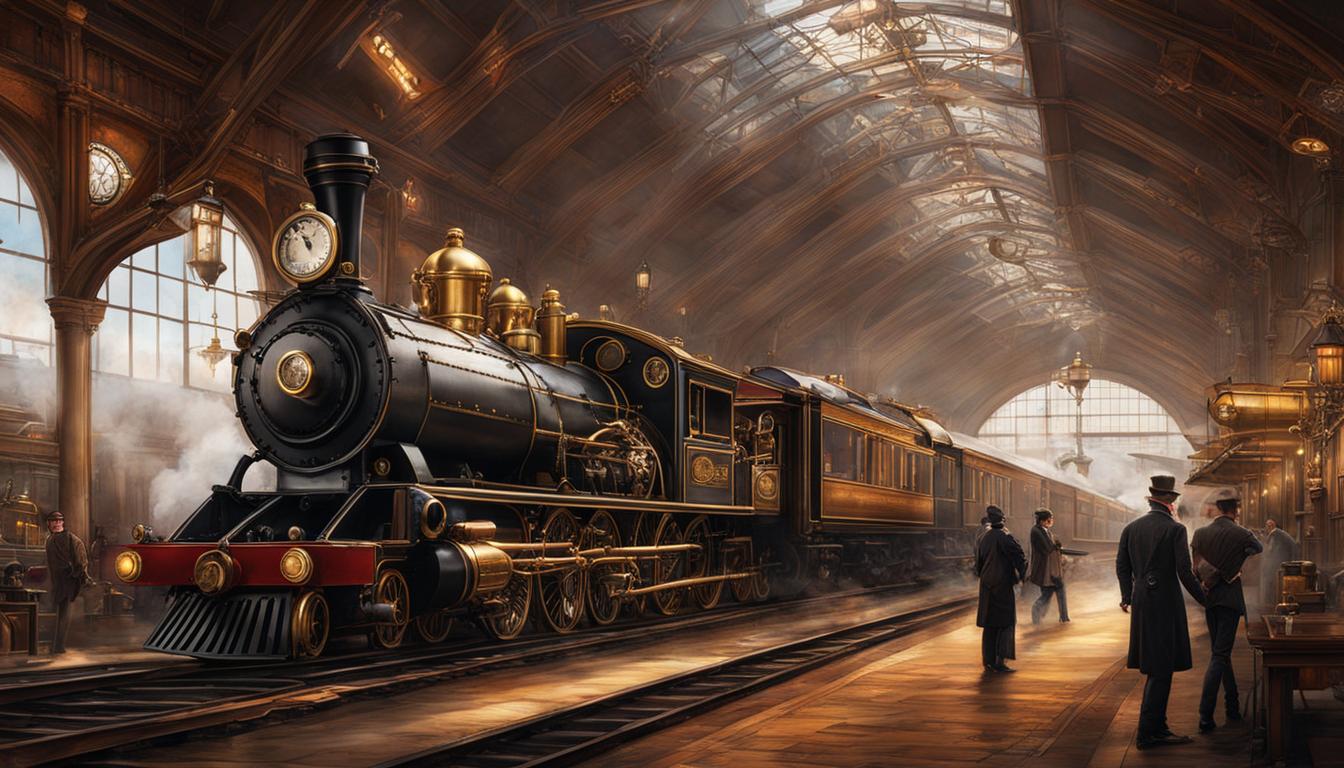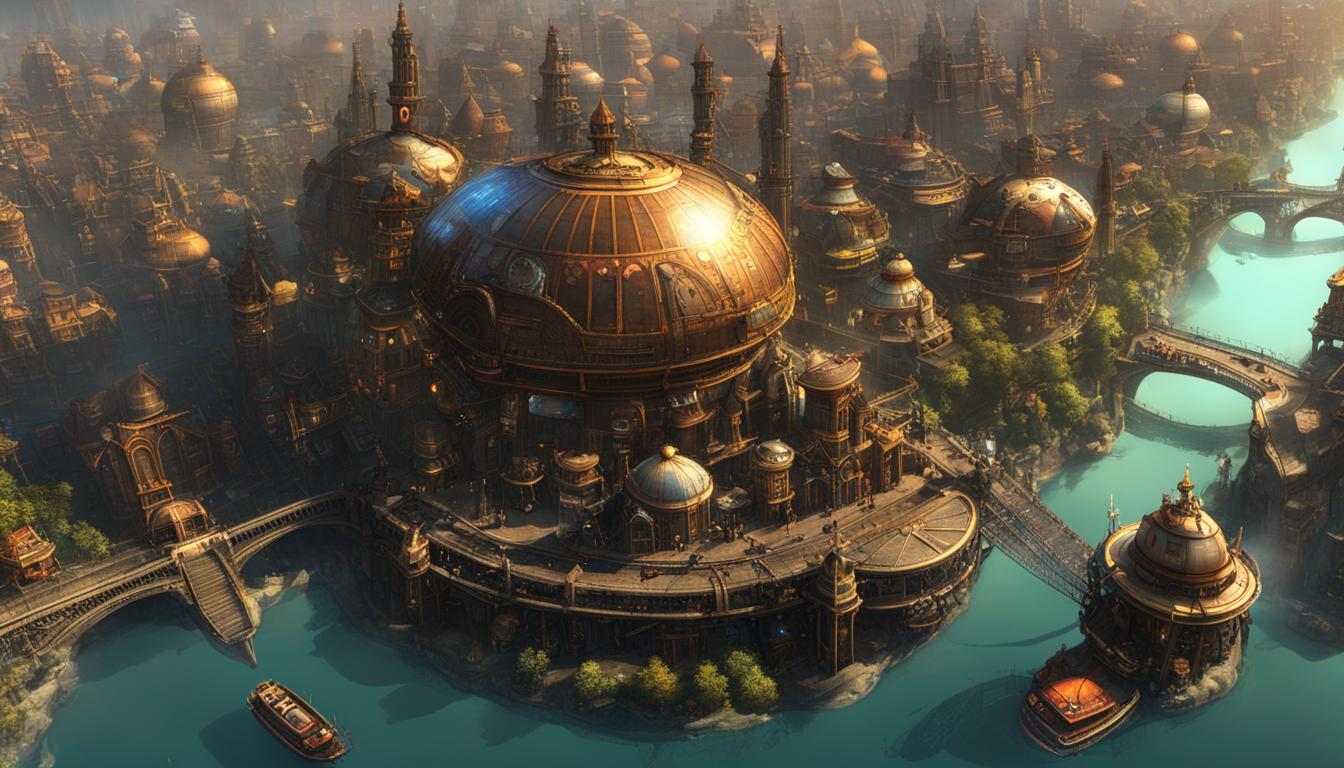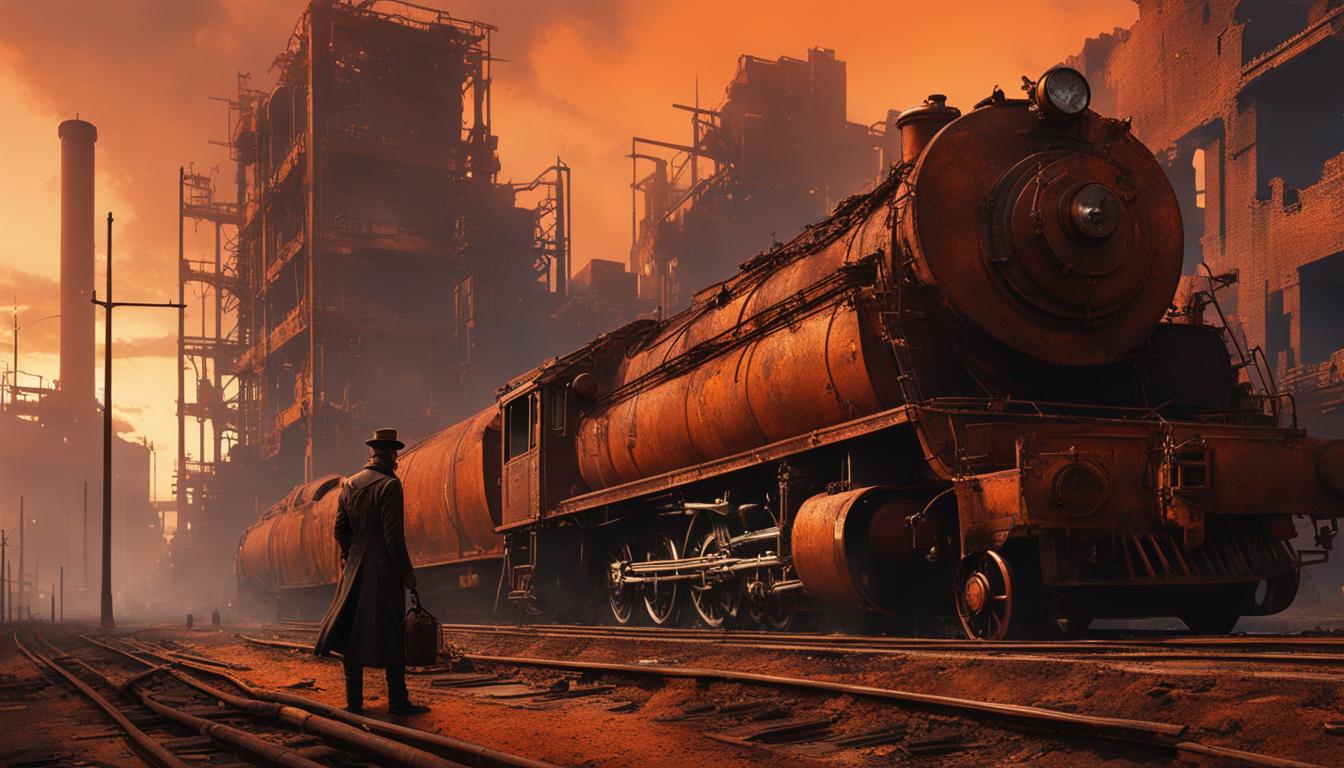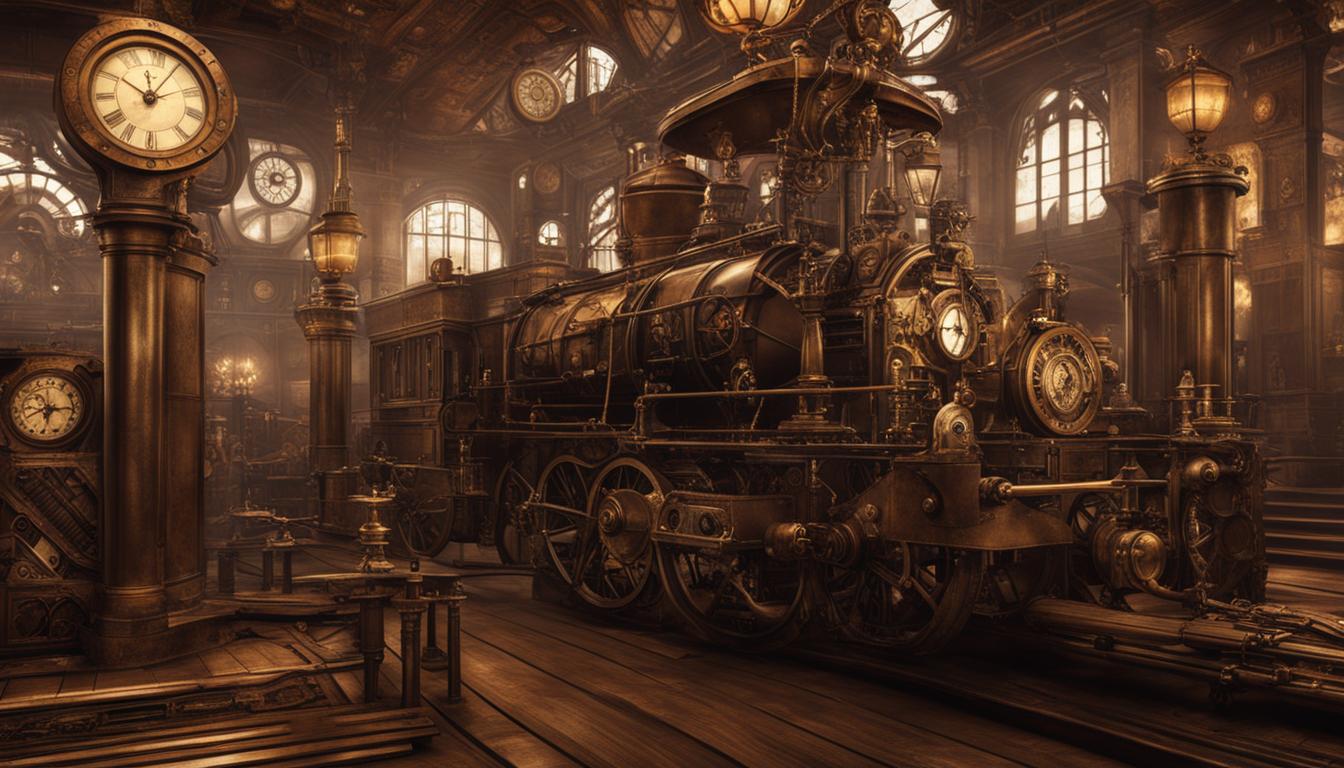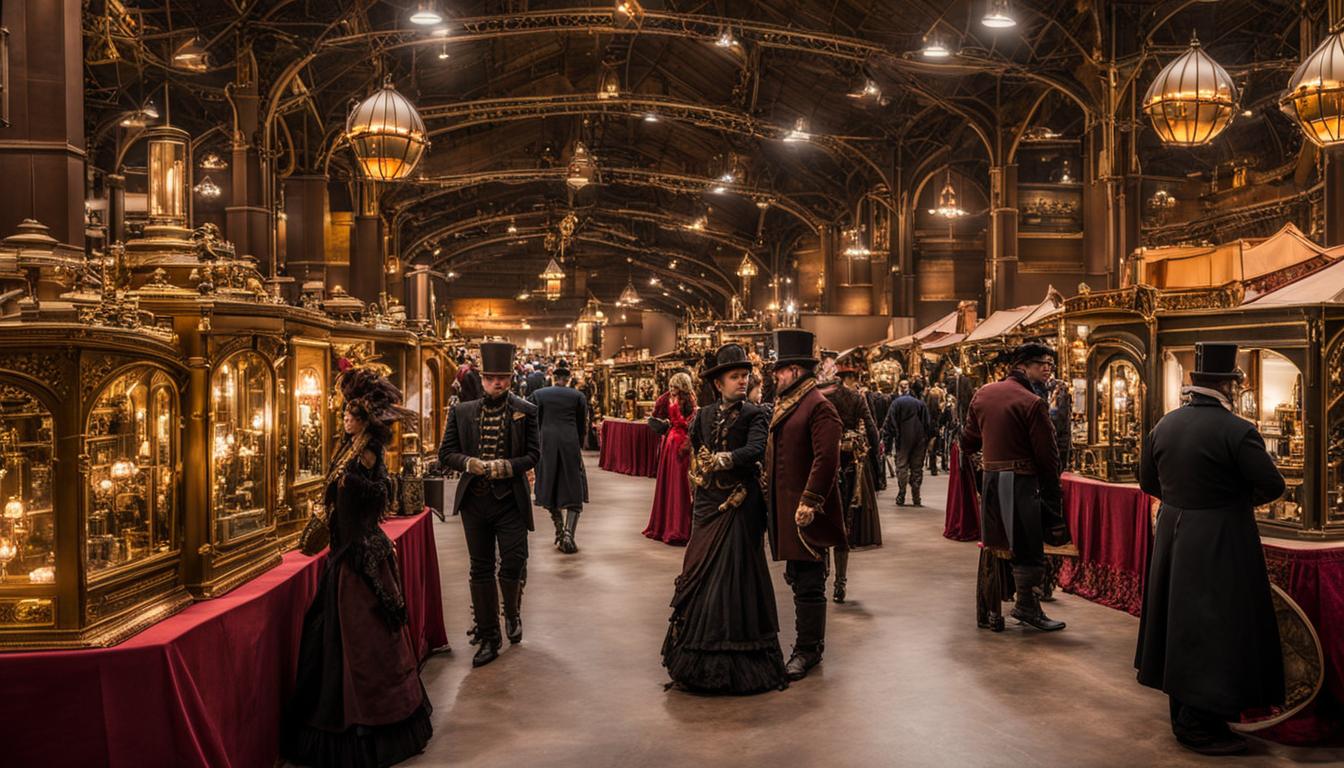Steampunk, a cultural movement that combines Victorian-era style with steam-powered technology, has emerged as a captivating force in various forms of media. From literature to film and television, steampunk offers a fresh perspective on history, breathing new life into historical events with its fantastical elements and futuristic inventions.
Steampunk transports audiences to alternate versions of the past, where Victorian aesthetics coexist with imaginative storytelling. This captivating blend of historical accuracy and whimsy has sparked the curiosity of enthusiasts around the world, drawing them into a world where steam-powered gadgets and elaborate costumes reign supreme.
Key Takeaways:
- Steampunk reimagines historical events by blending Victorian-era style with steam-powered technology.
- Historical accuracy is often intertwined with imaginative elements in steampunk narratives.
- Steampunk literature and visual media offer alternate histories and fresh perspectives on the past.
- Steampunk fashion showcases a fusion of Victorian-era fashion and futuristic elements.
- The steampunk community celebrates the genre through conventions, cosplay, and creative expression.
The Influence of the Victorian Era in Steampunk
The Steampunk Movement draws heavily from the Victorian Era, a period known for its ornate designs and social hierarchy. Within the steampunk genre, historical accuracy is often blended with imaginative elements, creating a unique fusion of past and future. Steampunk narratives often take place in historical settings, reflecting the societal structures and technological advancements of the Victorian era. While historical accuracy may not always be the main focus, steampunk provides a lens through which alternative histories can be explored and reimagined.
Blending History with Imagination
Steampunk media embraces the aesthetic and social structure of the Victorian era, incorporating elements such as corsets, waistcoats, top hats, and elaborate architecture. The attention to detail in steampunk’s visual representation of the Victorian era adds depth and immersion to the storytelling. However, the genre also allows for an imaginative twist, introducing futuristic inventions powered by steam, gears, and clockwork mechanisms.
“Steampunk provides a unique opportunity to blend history with imagination, offering a captivating escape into an alternate reality where steam-powered technology reigns supreme.”
Creating Historical Settings with a Twist
Steampunk stories often present historical events in a reimagined form, offering a fresh perspective on well-known narratives. By incorporating steampunk elements into historical settings, authors and creators can breathe new life into familiar stories, introducing unexpected plot twists and character dynamics. While the level of historical accuracy may vary, the steampunk genre opens up a world of possibilities for storytelling, allowing for the exploration of alternative histories and speculative scenarios.
Table: Elements of the Victorian Era in Steampunk
| Element | Description |
|---|---|
| Fashion | Corsets, waistcoats, top hats, goggles |
| Architecture | Ornate buildings, clock towers, steam-powered machinery |
| Social Hierarchy | Class divisions, aristocracy, Victorian etiquette |
| Technology | Steam-powered inventions, gears, clockwork mechanisms |
The Victorian era serves as a rich source of inspiration for the steampunk genre, providing a historical foundation that is both familiar and intriguing. By incorporating Victorian aesthetics and societal elements into their narratives, steampunk creators transport audiences to a world that merges the past with the future, offering a unique perspective on historical events and reimagining the possibilities of what could have been.
The Evolution of Steampunk Literature
Steampunk literature has undergone a remarkable evolution since its emergence in the 1980s. This unique genre encompasses a wide range of subgenres, including alternate histories and historical fiction, which blend seamlessly with the aesthetic and technological elements of steampunk. Influential authors such as Jules Verne and H.G. Wells are often hailed as pioneers of the steampunk movement, with their works serving as inspirations for contemporary steampunk tales.
Steampunk literature offers a captivating fusion of history and imagination, allowing authors to weave fantastical narratives that reimagine historical events. By incorporating steam-powered technology, elaborate gadgets, and futuristic inventions into their stories, these writers breathe new life into familiar historical periods. This blending of history with steampunk provides readers with fresh perspectives on the past, transporting them to worlds where the boundaries of time and possibility are pushed to the limits.
From epic adventures set in alternate versions of the Victorian era to intricate mysteries that unfold in steam-filled cities, steampunk literature offers a rich variety of storytelling possibilities. It combines the allure of historical accuracy with the thrill of imaginative exploration, creating a genre that appeals to both history enthusiasts and fans of speculative fiction. Whether it’s exploring the mysteries of the Industrial Revolution or reimagining famous historical figures, steampunk literature continues to captivate readers with its unique blend of history, fantasy, and innovation.
As steampunk literature evolves and gains more traction, it provides a platform for authors to push the boundaries of storytelling. Through their works, they not only pay homage to the Victorian era but also challenge conventional notions of history and invite readers to question the possibilities of the past. Steampunk alternate history stories and historical fiction carve out a space where the boundaries of reality are blurred, inviting readers on a thrilling journey through time and imagination.
Steampunk’s Visual Impact in Film and Television
The infusion of steampunk elements into the world of film and television has brought a fresh and captivating twist to historical tales. Steampunk versions of historical events transport audiences to a Victorian-inspired world, where steam-powered gadgets and elaborate costumes reign supreme. Productions like “The League of Extraordinary Gentlemen” and the BBC’s “Sherlock Holmes” series have successfully integrated steampunk aesthetics to reimagine iconic characters and breathe new life into familiar stories.
These adaptations offer a visual feast for viewers, showcasing the intricate details of steampunk-inspired sets and costumes. Steam-powered machinery, gears, and retro-futuristic contraptions create a whimsical and mysterious atmosphere, adding an extra layer of intrigue to the narratives. By blending historical settings with steampunk aesthetics, these productions create an immersive experience that transports audiences to an alternate version of the past.
“Steampunk versions of historical events transport audiences to a Victorian-inspired world, where steam-powered gadgets and elaborate costumes reign supreme.”
The visual impact of steampunk in film and television goes beyond aesthetics. It also serves as a vehicle for storytelling, allowing directors and creators to explore the possibilities of merging history with fantasy. Steampunk’s take on historical tales brings together elements of nostalgia, innovation, and adventure, captivating audiences and reigniting their interest in familiar narratives from a fresh perspective.
Steampunk Film and TV: A Table of Captivating Visuals
| Production | Release Year | Synopsis |
|---|---|---|
| “The League of Extraordinary Gentlemen” | 2003 | A group of extraordinary individuals with unique abilities is assembled to stop a villain from causing chaos in a steampunk-inspired Victorian England. |
| “Sherlock Holmes” (BBC Series) | 2010-2017 | Sherlock Holmes and Dr. Watson solve mysteries in a modern-day London infused with steampunk elements, blending the classic detective stories with retro-futuristic aesthetics. |
| “Wild Wild West” | 1999 | A government agent and his partner investigate a series of bizarre crimes, navigating a steampunk-inspired version of the American Wild West. |
As seen in the table above, steampunk-infused productions like “The League of Extraordinary Gentlemen” and the “Sherlock Holmes” series have captured the imaginations of audiences, showcasing the captivating visuals and immersive storytelling of the genre. By reimagining historical events with a steampunk twist, these productions continue to intrigue and inspire, leaving a mark on the world of film and television.
Steampunk’s Role in Reimagining Historical Events: The Steampunk Aesthetic and Fashion
The steampunk movement not only reimagines historical events through literature and media but also breathes new life into fashion and aesthetics. Steampunk’s unique blend of Victorian-era fashion and steam-powered technology creates a visually captivating and mysterious style that showcases the movement’s role in reimagining historical events.
Steampunk fashion is characterized by its fusion of Victorian-era clothing with futuristic elements. Corsets, goggles, top hats, and gears are common accessories in steampunk attire, paying homage to the historical styles of the Victorian era. This blend of past and future reflects steampunk’s ability to transport us to alternative versions of history, where steam-powered gadgets and elaborate costumes reign.
Emphasizing historical accuracy while incorporating imaginative elements, the steampunk fashion subculture showcases the performative nature of the movement. Enthusiasts create their own unique steampunk personas, adding their personal touch to the subculture. Through their creative expressions, they explore and reimagine historical events, infusing them with a touch of fantasy and whimsy.
Steampunk fashion not only pays homage to the historical styles of the Victorian era but also incorporates futuristic elements, reflecting steampunk’s role in reimagining historical events with a touch of fantasy.
The steampunk aesthetic goes beyond fashion and encompasses a wide range of artistic expressions. From jewelry and accessories to home decor and even furniture, the steampunk style showcases the movement’s impact on reimagining historical events through design and aesthetics.
Steampunk Fashion Elements
| Steampunk Fashion Elements | Description |
|---|---|
| Corsets | Tight-fitting bodices that accentuate the waist, influenced by Victorian-era fashion. |
| Goggles | Protective eyewear often associated with steampunk, representing the exploration of new frontiers and technological advancements. |
| Top Hats | Tall, cylindrical hats that symbolize elegance and aristocracy, a staple of the Victorian era. |
| Gears | Mechanical parts and gears used as accessories, representing the fusion of Victorian aesthetics with steam-powered technology. |
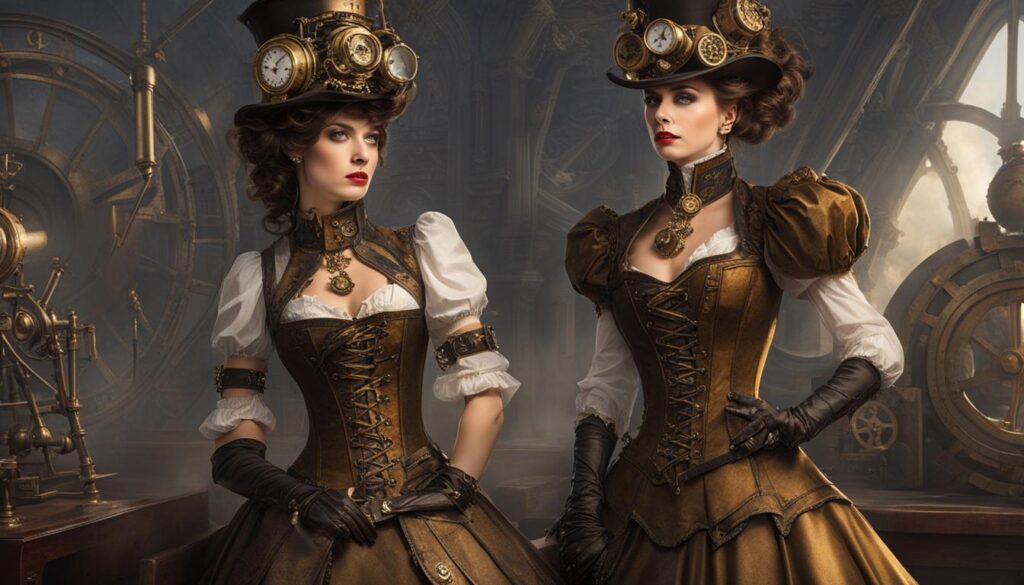
Steampunk Subcultures and Community
The world of steampunk extends beyond the pages of books and the screens of film and television. It has sparked the formation of vibrant subcultures and a passionate community that fosters creativity and imagination. At the heart of this community are the steampunk conventions, where enthusiasts come together to celebrate their shared love for the genre and its unique blend of history and fantasy.
Steampunk conventions are gatherings that take place in various cultural centers, attracting attendees from different regions and countries. These events serve as a hub for fans to showcase their creativity and immerse themselves in the world of steampunk. Cosplay is a highlight of these conventions, with attendees donning elaborate costumes inspired by the Victorian era, complete with corsets, goggles, top hats, and gears.
Aside from cosplay, steampunk conventions offer a wide array of activities and attractions. Art exhibits display intricate steampunk artwork, showcasing the talent and creativity of the community. Workshops and panels provide opportunities for attendees to learn new skills and engage in discussions about the genre. Live music performances add a lively atmosphere to the events, with bands incorporating steampunk elements into their music.
Steampunk conventions play a significant role in the exploration of historical settings in steampunk stories. Within the community, there is a strong emphasis on blending history with steampunk, allowing for the reimagining of historical events in imaginative and captivating ways. These conventions provide a platform for enthusiasts to come together, share their ideas, and appreciate the artistry and craftsmanship that go into creating steampunk-inspired works.
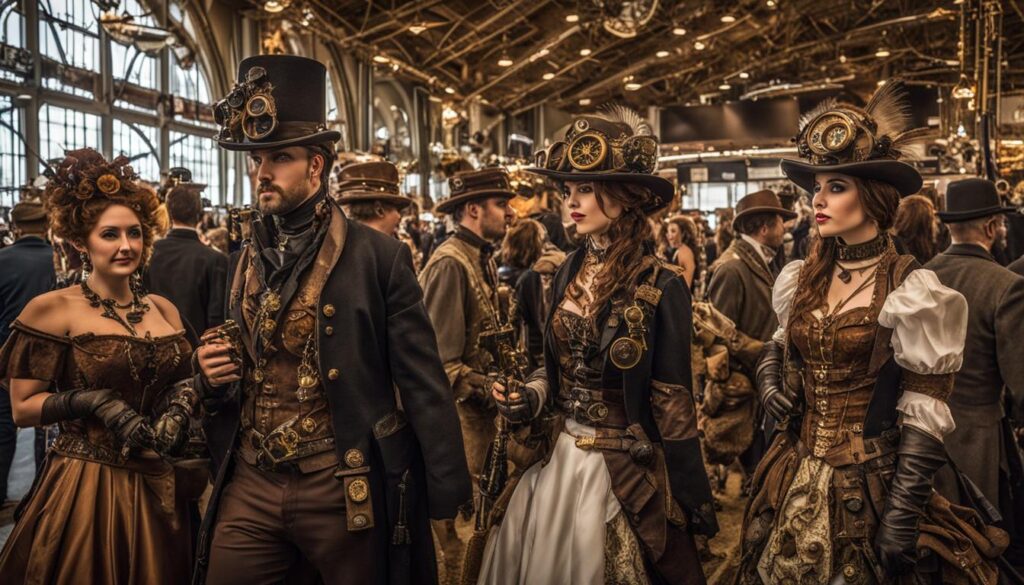
| Steampunk Conventions | Location | Date |
|---|---|---|
| Steamposium | Seattle, Washington | August 27-29, 2021 |
| The Asylum | Lincoln, United Kingdom | September 10-12, 2021 |
| Wild Wild West Steampunk Convention | Tucson, Arizona | TBD |
| Gaslight Gathering | San Diego, California | TBD |
These gatherings not only provide a sense of belonging to steampunk enthusiasts but also inspire the growth and evolution of the genre. As the community continues to thrive and expand, new stories, artwork, and innovations emerge, pushing the boundaries of steampunk’s role in reimagining historical events. Steampunk conventions are the heartbeat of the subculture, bringing together like-minded individuals who are passionate about exploring the possibilities of the past through a steampunk lens.
Conclusion
The mesmerizing world of steampunk has left an indelible mark on historical narratives, reimagining events in a way that captivates audiences around the globe. By blending the ornate elegance of the Victorian era with the fantastical allure of steam-powered technology, steampunk offers a fresh lens through which history can be seen.
From the pages of literature to the silver screen, steampunk’s impact on historical narratives is undeniable. Authors have skillfully woven alternate histories and imaginative elements into their stories, breathing new life into the past while incorporating the distinct aesthetic and technological aspects of steampunk.
But it is not only in the realm of storytelling that steampunk’s role in reimagining historical events shines. Film and television productions have embraced the steampunk aesthetic, transporting viewers to a world where iconic characters and historical tales are given a unique twist. These adaptations invite audiences to indulge in a sense of wonder and mystery, all while exploring the possibilities of blending history with fantasy.
As the steampunk movement continues to evolve, it will undoubtedly inspire future creations, leaving an enduring impact on the reimagining of historical events in media. Steampunk’s ability to seamlessly merge the past with the future offers endless opportunities for storytelling, enchanting us with its whimsy and reminding us that history is never set in stone.
FAQ
What is Steampunk?
Steampunk is a cultural movement that blends Victorian-era style with steam-powered technology, creating a unique aesthetic and storytelling approach.
How does Steampunk reimagine historical events?
Steampunk offers a reimagining of historical events by presenting alternate versions of the past that incorporate fantastical elements and futuristic inventions.
What forms of media does Steampunk influence?
Steampunk has made its mark in various forms of media, including literature, film, and television.
What are some examples of Steampunk literature?
Authors such as Jules Verne and H.G. Wells are considered pioneers of the steampunk genre, with their works often serving as inspiration for contemporary steampunk tales.
How does Steampunk impact film and television?
Productions such as “The League of Extraordinary Gentlemen” and the BBC’s “Sherlock Holmes” series have incorporated steampunk elements to reimagine historical events and iconic characters.
What is the Steampunk aesthetic?
The steampunk aesthetic is characterized by a blending of Victorian-era fashion and steam-powered technology.
Does Steampunk have a community?
Steampunk has a vibrant subculture and community that spans across different regions and countries, with conventions and events where enthusiasts can celebrate the genre.

